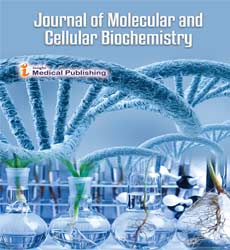Structural Insights into ProteinâÂÂProtein Interactions in Cellular Signaling
Ushi Torkel*
Department of Molecular Biology, University of Medicine and Pharmacy, 700115 Iasi, Romania
*Corresponding author:
Ushi Torkel,
Department of Molecular Biology, University of Medicine and Pharmacy, 700115 Iasi, Romania,
E-mail: Torkel.ushi@gmail.com
Received date: February 03, 2025, Manuscript No. ipmcb-25-20692; Editor assigned date: February 05, 2025, PreQC No. ipmcb-25-20692 (PQ); Reviewed date: February 10, 2025, QC No. ipmcb-25-20692; Revised date: February 17, 2025, Manuscript No. ipmcb-25-20692 (R); Published date: February 24, 2025
Citation: Torkel U (2025) Advancements in Minimally Invasive Surgery: Case Studies and Clinical Insights. J Mol Cell Biochem 10.1:01.
Introduction
Cellular signalling is the foundation of biological communication, ensuring that cells respond appropriately to internal and external stimuli. From regulating growth and differentiation to orchestrating immune responses and maintaining homeostasis, signaling pathways govern virtually every aspect of cellular life. At the core of these processes lie proteinâ??protein interactions, which form the structural and functional framework upon which signals are transmitted, modulated and integrated. Understanding how proteins interact at the molecular level provides essential insights into the mechanisms of signaling networks and offers pathways for therapeutic intervention in diseases where signaling goes awry. With advances in structural biology, computational modeling and biophysical techniques, researchers have begun to unravel the intricate architectures and dynamics of protein complexes that drive cellular communication [1].
Description
Proteinâ??protein interactions are central to the assembly of signaling complexes that facilitate the relay of information within and between cells. Unlike small molecules, proteins possess diverse structural domains, motifs and surface chemistries that enable specific and often transient interactions. Structural biology has revealed that these interactions are mediated by a wide range of binding interfaces, ranging from large, stable contact surfaces to small, modular domains that recognize short linear motifs. Such diversity allows for both the stability required in signaling complexes and the flexibility necessary for dynamic regulation. A key feature of proteinâ??protein interactions in signaling is modularity.
Domains such as SH2, SH3, PDZ and PH serve as recognition modules that bind phosphorylated residues, proline-rich motifs, or membrane-associated lipids. These domains act as molecular â??readersâ? of signaling cues, ensuring that pathways are activated only under specific conditions. For example, SH2 domains recognize phosphorylated tyrosine in receptor tyrosine kinase pathways, thereby recruiting downstream effectors and propagating signals that control cell proliferation. Similarly, PDZ domains facilitate the clustering of receptors and channels at the membrane, coordinating responses to environmental signals. Structural studies of these modules have revealed how subtle differences in binding pockets confer selectivity, enabling highly specific signaling outcomes despite the vast complexity of cellular environments [2].
Importantly, these structural transitions highlight the role of flexibility and disorder in signaling proteins, particularly in intrinsically disordered regions that lack stable structures but become ordered upon binding to partners. Recent advances in cryo-EM and X-ray crystallography have enabled high-resolution visualization of large signaling assemblies that were once intractable to study. Complexes such as the inflammasome, apoptosome and transcriptional machinery have been resolved, providing unprecedented insights into how multiple proteins assemble into functional units. These structural revelations have underscored the cooperative nature of proteinâ??protein interactions, where multivalency and clustering amplify signals and creates platforms for downstream processes. Additionally, single-particle cryo-EM has shown how dynamic rearrangements within these complexes fine-tune signaling outputs, emphasizing that structure and function are inseparable in cellular communication. Computational modeling and molecular dynamics simulations complement experimental approaches by offering dynamic perspectives on proteinâ??protein interactions. While crystallography provides static snapshots, simulations allow researchers to observe how binding events occur in real time, how conformations fluctuate and how post-translational modifications influence interactions. This integrative approach has been instrumental in mapping signaling pathways such as NF-κB and Wnt, where transient and weak interactions are critical for function but difficult to capture experimentally. Advances in artificial intelligence-driven protein structure prediction, exemplified by AlphaFold, are accelerating the pace at which researchers can model interactions and generate hypotheses for experimental validation.
Conclusion
Structural insights into proteinâ??protein interactions have revolutionized our understanding of cellular signaling, revealing the molecular logic that underlies complex biological communication networks. By elucidating how proteins recognize, bind and regulate one another, structural biology has provided critical knowledge for deciphering signaling pathways and their dysregulation in disease. Advances in experimental and computational methods have illuminated the dynamic, modular and cooperative nature of these interactions, underscoring their role in ensuring specificity, efficiency and adaptability. Beyond deepening our fundamental understanding of biology, these insights have had profound translational impact, guiding the development of therapies that target aberrant signaling in cancer, immune disorders and other diseases. As the field continues to evolve, integrating structural data with systems biology, genomics and artificial intelligence will further unravel the complexities of protein interactions, opening new frontiers in cellular signaling research and therapeutic innovation.
Acknowledgement
None.
Conflict of Interest
None.
Reference
- Hansman MF, Ryan JA Jr, Holmes JH 4th, Hogan S, Lee FT, et al. (2001) Management and long-term follow-up of hepatic cysts. Am J Surg 181: 404-410.
Google Scholar Cross Ref Indexed at
- Jian-Guo Q, Hong W, Hui J, Ji-Wei H, Prasoon P (2011) Laparoscopic fenestration vs open fenestration in patients with congenital hepatic cysts: A meta-analysis. World J Gastroenterol 17: 3359-3365.
Open Access Journals
- Aquaculture & Veterinary Science
- Chemistry & Chemical Sciences
- Clinical Sciences
- Engineering
- General Science
- Genetics & Molecular Biology
- Health Care & Nursing
- Immunology & Microbiology
- Materials Science
- Mathematics & Physics
- Medical Sciences
- Neurology & Psychiatry
- Oncology & Cancer Science
- Pharmaceutical Sciences
